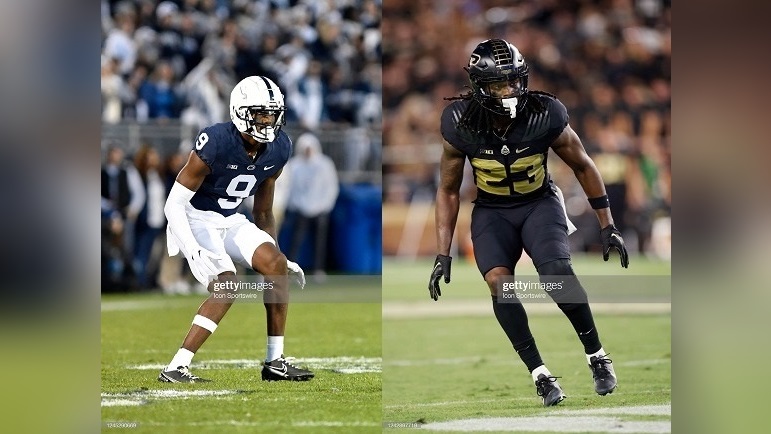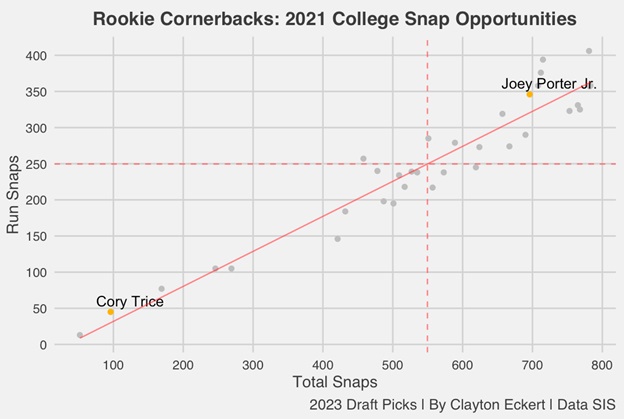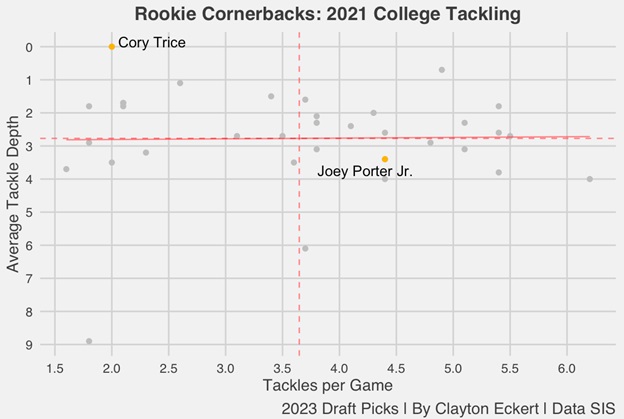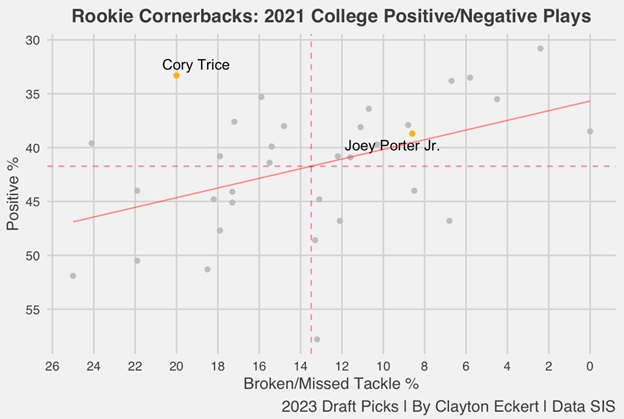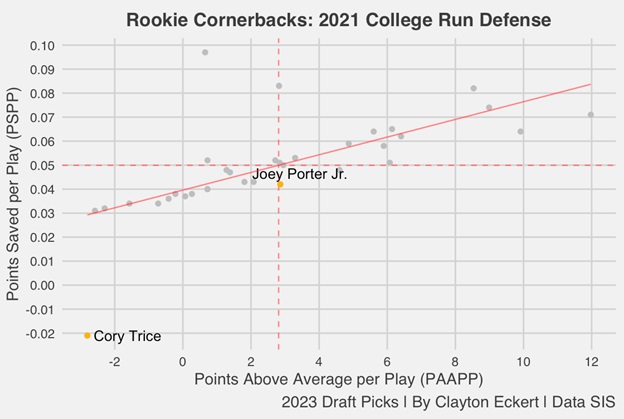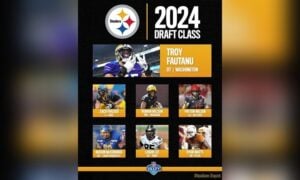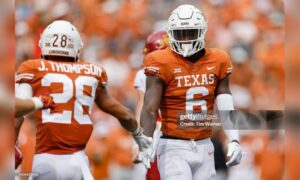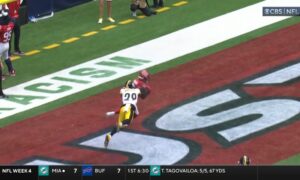Wrapping up the series, I wanted to circle back to the cornerback position, this time looking at run defense in the 2021 season following my 2022 coverage, 2022 run defense, and 2020-2021 coverage articles. Pittsburgh was luckily able to select Joey Porter Jr. at 32nd overall, along with Cory Trice Jr. in the seventh round.
Today’s goal is to look at and provide stat context for the position using Sports Info Solutions (SIS). The data in this study will focus on the players who heard their names called in the draft, and two players were excluded due to SIS not tracking smaller schools or from not playing. The goal is to see how Porter and Trice stacked up among their peers.
First, let’s look at run snaps along with their total snaps to get a gauge of the players’ opportunities, and how often they were able to stay on the field for their squads:
Porter lands on an ideal spot on the top right in snap opportunities, with 696 total snaps (10th) and 346 run snaps (seventh) among the 34 qualifying cornerbacks. He started in all 12 regular season games in 2021, compared to last season when he started in 10 games, missing two due to injury and had the second least snap opportunities in this year’s draft class at the position. Availability is obviously a huge baseline for any player to succeed, and here’s to hoping Porter Jr. can provide just that in his rookie season.
This point is even more valid for Trice, who had the second least snap opportunities in 2021 among the cornerback draft class this year. He played in only two games in 2021 due to two injuries, highlighted well by our own Melanie Friedlander. Last season provided optimism, starting in 12 games, and ranked 22nd in total snaps along with 19th in run snaps. Knock on wood Trice can put his injury history behind him as he did in 2022, which was the main reported reason his talents were available to Pittsburgh late in the draft, and the two can provide healthy and productive rookie seasons and beyond.
Next, let’s look at a very important aspect of being a quality run defender, tackling. The chart below looks at the players’ tackles per game and average tackle depth, with the latter suggesting quality play up front and attacking the line of scrimmage:
Right away we see Trice had the top-ranked average tackle depth of zero yards, but an important context to recall is his lack of snaps, with this result coming on just four combined run tackles for an average of two tackles per game (T-29th). With much more opportunity in 2022, Trice also ranked impressively at eighth in average tackle depth which he can hopefully continue to provide for the Black and Gold. Trice also with increasing his tackles per game to 3.2, but was still below the mean in the draft class.
In 2021, Porter fared best in quantity, with 4.4 tackles per game which tied for 10th, but had a below-the-mean 3.4 average tackle depth (26th). Comparing this to last season, he had a healthier 2.5 average tackle depth (15th) but fewer tackles per game (three) which tied for 27th. Encouraging aspects when looking at the last two seasons is a positive trend in average tackle depth for Porter, and while the sample size for Trice was extremely small in 2021, he was well above average in tackle depth each season. Very important as we learn more and anticipate what they can hopefully carry over in their NFL opportunities.
This next view attempts to weigh positive and negative plays, using broken and missed tackle rates (negative plays) along with Sports Info Solutions’ positive play percentage which is the rate of run plays with the player on the field that resulted in positive expected points added (EPA), with lower percentages being the best:
Landing above the mean in both data points is Porter Jr., with a strong 8.6% broken/missed tackle rate (eighth) and a 38.7 positive play percentage (13th). Nice numbers in the 2021 regular season, but unfortunately there was a regression last year when he tied for 21st in broken missed tackles (14.3%) and a lower 41.7 positive play rate that ironically also ranked 13th. Trice lands on the top left, with his 33.3 positive play percentage ranking second (on a small sample size in 2021), but struggled in terms of broken/missed tackles at 20% (30th).
Comparing this to 2022, Trice made a substantial improvement to second best with a 5% broken/missed tackle rate and a just above average 11th rank in positive play percentage, landing him above the mean in both, and very encouraging recent performance considering much more playing time. The lack of consistency the last two years in terms of broken/missed tackles will be crucial to monitor for both players, but seeing their above-average positive rates for their teams each season is promising.
To close, here is a more total view of the players in the run game using points saved per play (the total of a player’s EPA responsibility on run plays using the Total Points system that distributes credit among all players on the field for a given play (with positive numbers being good). Totals are scaled up to map to the average points scored or allowed on a team level, with the player’s snap count determining how much to adjust.
For run defense, that includes accounting for defenders in the box, blown blocks forced, broken tackles, turnovers, and turnover returns.) and points above average per play (using the same Total Points system and putting a number to their value above an average level player):
Here we see Porter with the better overall marks, landing virtually at the mean in PAAPP which ranked 14th, but his PSPP was below average and ranked 23rd. He was below the mean in both last seasons, ranking 23rd in both data points, which re-emphasizes the earlier point of a bit of regression in 2022. Trice’s 2021 plot point is very stark, ranking dead last in both data points in his injury-riddled season.
He was also below the mean in both data points last year but trended positively to a more respectable 25th in each. So, both draft picks were largely below average each of the last two years from an SIS points perspective compared to their peers in run defense.
Overall, Porter’s above-average marks in 2021 were run snaps (seventh), broken/missed tackle percentage (eighth), total snaps (10th), tackles per game (T-10th), and positive rate (13th), at the mean in PAAPP (14th), and was below the mean in just PSPP (23rd) and average tackle depth (26th). In 2022, he improved his tackle depth (15th) and was above average in positive rate again (13th), but was below the average drafted cornerback in several aspects: broken/missed tackle percentage (T-21st), PAAPP (23rd), PSPP (23rd), tackles per game (27th), total snaps (34th), and run snaps (34th). Obviously not the trend you’d like to see, and can’t wait to see how he fares as an NFL run defender.
In 2021, Trice had strong ranks in average tackle depth (first) and positive play rate (second), but played just two games, and was below average in every other aspect of the study: tackles per game (T-29th), broken/missed tackle rate (30th), total snaps (33rd), run snaps (33rd), along with dead last ranks in PAAPP and PSPP out of the 34 qualifying corners. Last season he trended positively in a few areas, most impressively to a second rank in broken/missed tackle rate, along with solid results in average tackle depth (eighth), and positive rate (11th), while his below-average marks were opportunities (slightly), PAAPP (25th), PSPP (25th), and tackles per game (T-29th).
Hopefully Trice can provide continued availability as he did in 2022, which is encouraging considering his past injuries. Here’s to hoping his recent health prevails, a risk Pittsburgh was willing to take for a hopeful late-round reward. One thing’s for sure, I can’t wait to see how it plays out for the rookie cornerbacks this year and beyond.
How do you think Porter and Trice will fare in their rookie year? Thanks for reading and let me know your thoughts in the comments.

